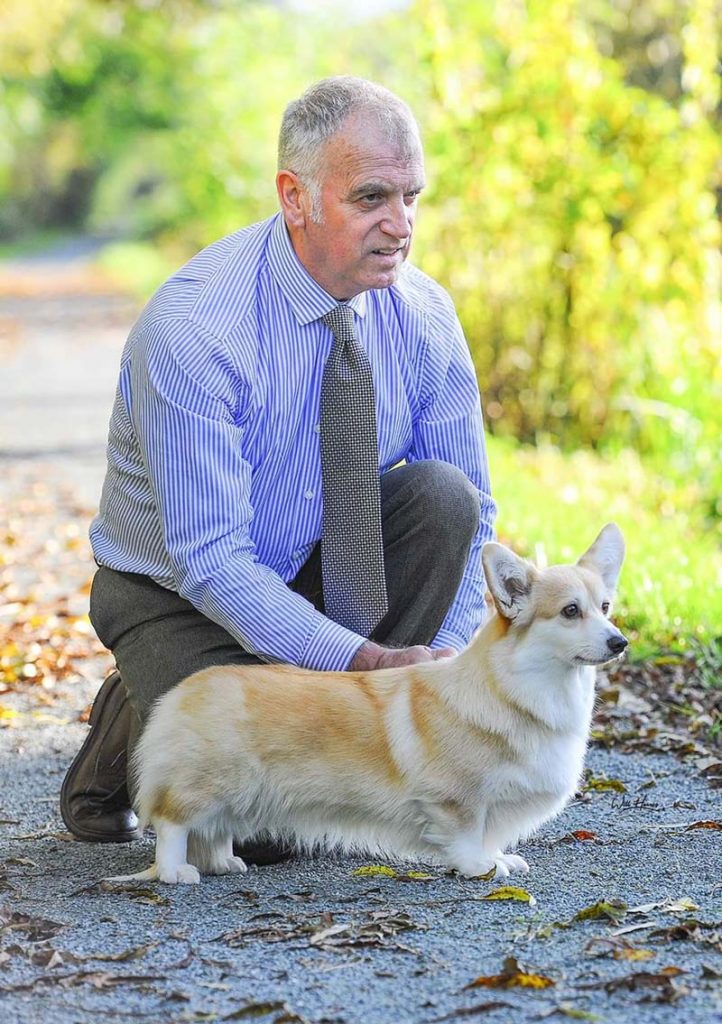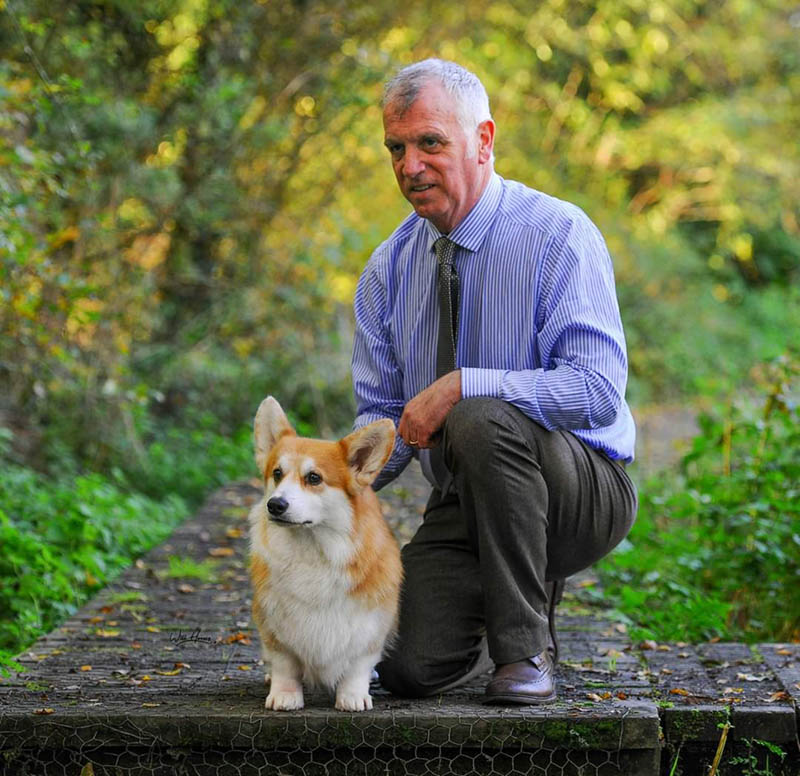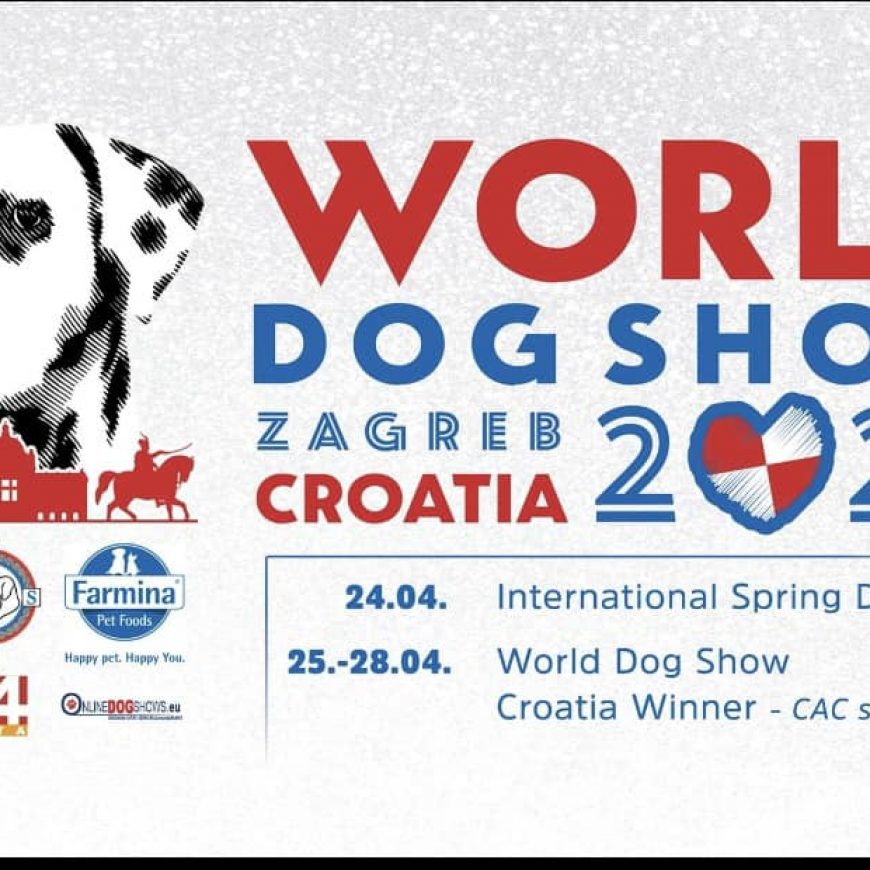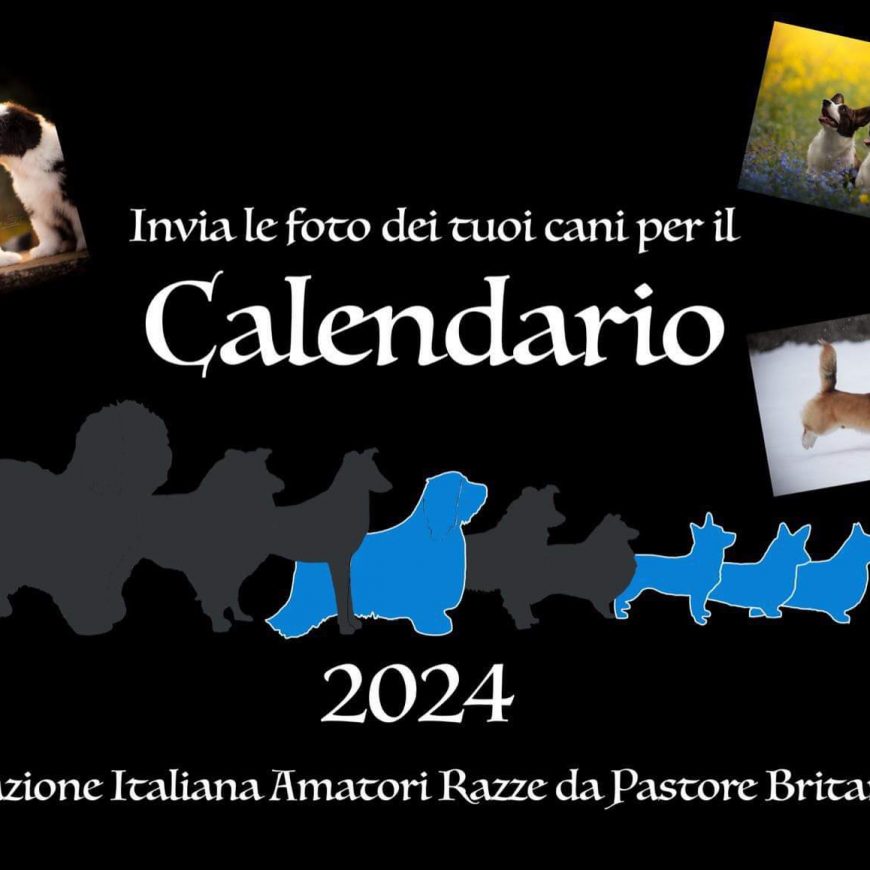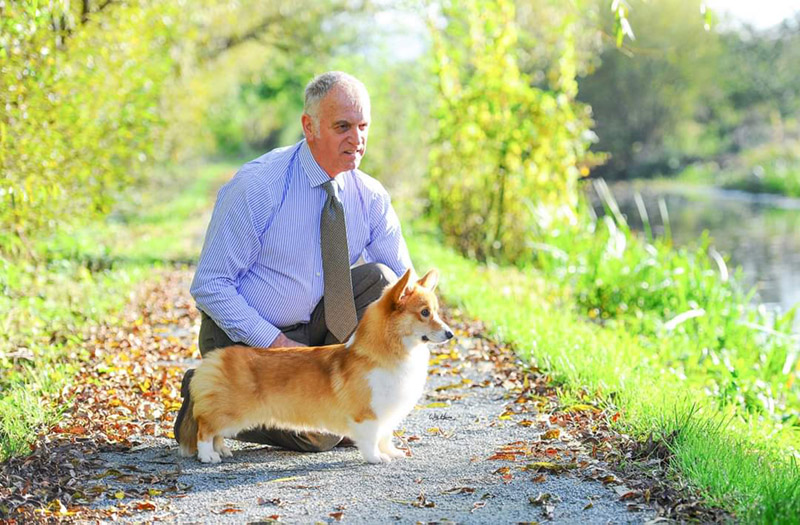
Iniziamo questa settimana una nuova rubrica contenente interviste ad Allevatori, Giudici, Educatori Cinofili, Handler. La prima intervista è a Kevin John Dover, Allevatore di Welsh Corgi Pembroke e Welsh Corgi Cardigan (Belroyd/Pemcader)) oltre che Giudice.
1. Tell us about you, how long have you had and bred Pembrokes ? And how long for the Cardigans?
I have ALWAYS been around Pembrokes as I was brought up in a Corgi household as my uncle was also a breeder and judge. I actually purchased my first Corgi in 1976 and bred my first litter in 1978 and have been breeding and showing them ever since so I am just coming up to my 44 th year in owning a Pembroke. We have been fortunate to have made up many champions here in the UK with many more overseas and proud to have bred and own the top winning CC winner in the UK of all time. I have had the pleasure to have judged both breeds all over the world as well as both breeds at Crufts. In respect to the Cardigans, I was asked to show a bitch that had been imported by the Tonkyn’s here i n the UK as the daughter unfortunately passed away suddenly. At her very first show in the UK she was awarded the CC and I was hooked. After I made her up we were fortunate to be offered a pick of litter puppy from her and we chose a lovely Brindle & White who by the time she was 1 year old had 2 CC’s and 2 reserves – I subsequently made her up at Crufts the following year. Since then we have made up several champions and one of our males has sired 3 separate group winners here in the UK and been the top sire for the last 5 years.
2. What are, according to you, the most important points in the Pembroke standard? And in the cardigan standard?
As far as the standard is concerned in either breed my priority has to be TYPE – without type you don’t have a breed or any breed for that matter ! Our standard is very specific in respect to the head and this is very important for any new judge – unfortunately you see many very poor heads that lack the required triangle with some having too deep a stop, small ears and incorrect eye shape etc. A good Pembroke should have a good strong neck and a level topline with well angulated front and back ends. Movement is also very important – I see too many people running around the ring – this is not desirable as this just proves that the handlers are trying to hide something !Bone and feet are also points that require attention – these are working dogs, they need good tight feet with the two center toes slightly ahead of the two outer ones. There also seems to be a lot more white appearing on the heads and necks – whilst the standard is very specific about what is permissible I have seen many with too much on the head and also up over the shoulder which is NOT permissible. Size is also another problem with many being far too big – again the standard is very specific and breeders should bear this in mind. The Cardigan is a totally different dog compared to the Pembroke – the head shape is different with a larger ear that should have rounded tips. The front assembly is different in that the front feet should turn out slightly but not exaggerated and the foot shape should be rounded and padded. The body length is also longer than the Pembroke and they should have a sloping croup unlike the Pembroke. Due to the slope the tail tends to be carried lower unlike the Pembroke that due to the high tail set holds it up when on the move. Colours in both breeds also differ – Brindle and Blue Merle are NOT allowed in the Pembroke.
3. What are the qualities you look for when breeding?
The qualities I look for when breeding is very easy – TYPE, TYPE, TYPE ! You need to look at what each of the parents have to offer and see what they have that compliments and what factors need addressing. Without breed type you will find improvement very difficult.
4. You need to choose a puppy to keep, what do you look for when you make this choice?
When choosing a puppy I look for the features I have found repeating itself in each of the litters we have bred. We tend to find that one or two puppies fit our blueprint after just a few days and this knowledge comes through studying our pedigrees and knowing what our dogs/bitches have to offer and what they lack so in theory we have a rough idea as to what the resulting puppies should end up like. We look for breed type, balance, movement and attitude. This is the ideal package but as we all know you are very lucky to get everything we desire !
5. When mateing your bitches, what are you looking for in the future stud?
When mating bitches we look long and hard at what they lack and then hopefully a dog that excels in those areas. We also want some thing that is line bred not necessarily on our lines but has some good producers in the background. This is not always easy these days as breed numbers are not as prolific as in the past and quality males are very few and far between. That is why we have had to bring in several males from overseas to take the kennel forward along with our own top male who thankfully has also been a very good producer.
6. In your opinion what is the current situation with the breed in UK and Overseas?
The situation in the Uk is not particularly good – many exhibitors lack the knowledge and seem to just take anything in the ring. Thankfully with my overseas appointments I have found quality to be quite high which is gratifying that there could be some males available to use in the future. We have also just brought in a very well bred male from Australia which we feel has the right combination of breed type, confirmation and movement and has a tremendous personality.
7. Do you reckon there are particular problems in the breed that you feel should be kept at close sight?
There are a few problems in my opinion – movement, size and colour. Many lack the drive and reach that a working dog should have with many moving more like a show pony lifting the front up high. Size is also another big problem – some bitches I have seen are built more like males and in some instances are bigger ! Colour – many are now getting very pale to the point that one European judge mentioned in their notes on an appointment here that the colour was Lemon !!! NOT DESIRABLE !!
8. Which are the show results you are most proud of, and your most precious memories?
Obviously having Thunderball has given us the most memorable times but I guess taking Group 2 at Crufts in 2018 has to be the highlight although having won 59 CC’s , BIS All Breed Show (14,000 dogs entered) Groups, Club Show BIS’s we have been very spoilt !
9. What advise would you give to a newcomer to the breed who would like to buy a puppy? And to the newcomer who would like to start breeding?
For anyone coming into the breed I can only reiterate what many books say to do and that is to buy the best bred bitch you can. She doesn’t have to be a big winner in the show ring but as long as her breeding is good and she is a nice type she can hopefully be put to a well bred dog to take them forward. It helps to visit a few kennels to look at their dogs to see if they are of a “type” which will bear fruit in the long term not just go after the first litter advertised. It is better to wait for a year or so for the right one to be born than to take just anything.
10. Which are the major faults you see today in the breed? The major faults I think I have covered previously but breed type, movement, size and colour (excessive white) and pale coats.
1) Parlaci di te, da quanto tempo hai allevato Pembrokes? E per quanto tempo i cardigan?
Sono SEMPRE stato in mezzo ai Pembroke, in quanto sono cresciuto in una casa cinofila, in quanto mio zio era sia un allevatore che un giudice. In realtà mi sono comperato il mio primo corgi nel 1976, e ho allevato la mia prima cucciolata nel 1978. E’ da allora che allevo ed espongo. Il che significa che sono 44 anni che possiedo Pembroke. Siamo stati fortunati nell’aver portato al successo molti campioni sia in UK con molti anche a livello internazionale. Fieri di aver allevato e di possedere il Pembroke, che detiene il record di CC in UK di tutti i tempi. Ho avuto il piacere di poter giudicare entrambe le razze, in tutto il mondo, ed anche al Crufts.
Per quanto riguarda il cardigan, mi era stato chiesto di esporre una femmina che era stata importata dai Tonkyn, qui in Inghilterra, in quanto loro figlia mori’ improvvisamente, le fu assegnato il CC ed io me ne innamorai.Dopo averle fatto finire il campionato fummo fortunati e ci venne offerta la prima scelta di cucciolata dalla medesima femmina, noi scegliemmo una bellissima brindle e bianca, che all’età di un anno aveva già 2 CC e due riserve. Fini’ il suo campionato al Crufts l’anno successivo. Da allora abbiamo allevato diversi campioni, Ed uno dei nostri maschi e’ padre di tre diversi vincitori di raggruppamenti, Ed e’ il TOP STUD (riproduttore top) degli ultimi 5 anni.
2) Quali sono secondo te i punti più importanti dello standard dei Pembroke? E nello standard dei Cardigan?
Per quanto riguarda lo standard di entrambi, la mia priorià’ e’ sempre LA TIPICITA’ – senza tipicià’ non hai la razza, questo vale per tutte le razze. Il nostro standard e’ molto specifico al riguardo della testa, e questo e’ molto importante per i neo giudici, sfortunatamente si vedono un sacco di teste non qualitative alle quali manca il triangolo richiesto, con alcune che presentano profondi stop, orecchie piccole, occhi di forma sbagliata ecc.. Un buon Pembroke dovrebbe avere un collo forte e lungo, una dorsale dritta, con anteriori e posteriori ben angolati. Anche il movimento e’ molto importante, – vedo troppa gente correre nel ring – questo non e’ desiderabile in quanto dimostra che gli handlers stanno provando a coprire i difetti. L’ossatura ed i piedi sono un altro punto a cui fare attenzione, questi sono cani da lavoro, necessitano di piedi forti e compatti, con le due dita centrali leggermente avanti rispetto a quelle laterali. Sembra ci sia sempre più bianco presente su teste e colli – nonostante lo standard sia molto chiaro per quanto riguarda il bianco ammesso – ho visto tanti cani con troppo bianco sulla testa, e anche fine sopra le spalle. Questo NON e’ permissibile! Anche la taglia e’ un problema, con alcuni soggetti troppo grandi, anche qui, lo standard e’ molto preciso, e gli allevatori devono tenerlo ben in mente. Il Cardigan e’ un cane totalmente diverso, paragonato al Pembroke. La forma della testa e’ diversa, con orecchie larghe con punta arrotondata. Anche la conformazione dell’anteriore e’ diversa in quanto i piedi davanti devono essere rivolti leggermente in fuori. con i piedi rotondi e paffuti. Anche il corpo e’ piu lungo di quello del Pembroke, con una groppa spiovente. Diversamente dal Pembroke, a causa della groppa spiovente, il Cardigan tiene la coda piu bassa in movimento a differenza del Pembroke, che ha la coda attaccata piu in alto e di conseguenza porta la coda più in alto in movimento. Anche i colori delle due razze sono diversi. Il Brindle e il blue merle NON sono ammessi nel Pembroke.
3) Quali sono le qualità che cerchi durante la riproduzione?
La qualità che cerco quando allevo e’ facile, TIPO – TIPO – TIPO. Bisogna guardare a cosa può offrire ciascun genitore, e guardare come si possono completare a vicenda, e quali fattori vanno migliorati. Senza la tipicità queste caratteristiche saranno dure a trovarsi.
4) Devi scegliere un cucciolo da tenere, cosa cerchi quando fai questa scelta?
Quando devo scegliere un cucciolo, cerco le caratteristiche che ho riscontrato nelle cucciolate precedentemente allevate. Abbiamo riscontrato che di solito uno o due cuccioli si adattano al nostro stampo, a soli pochi giorni, e questo avviene perchè la conoscenza delle nostre linee di sangue ci permette di sapere cosa hanno da offrire o cosa hanno da migliorare sia i nostri cani che le nostre femmine. Per cui in teoria sappiamo a grandi scale, cosa ci dobbiamo aspettare dalla cucciolata. Noi se cerchiamo la tipicità di razza, equilibrio, movimento ed attitudine. Questo sarebbe il pacchetto complete, ma come sapete, bisogna essere molto fortunati nel riuscire ad avere il pacchetto completo.
5) Quando accoppi le tue femmine, cosa stai cercando nel futuro stallone?
Quando accoppiamo le femmine, valutiamo a lungo in che cosa e’ carente, per poi trovare il maschio che può migliorare queste carenze. Cerchiamo anche soggetti allevati in line breeding (non necessariamente le nostre), ma che hanno buoni riproduttori tra le generazioni passate. Oggi questo non e’ semplice perchè il numero dei soggetti non e’ elevato come un tempo, e buoni soggetti sono sempre meno, e spesso lontani. E’ per questo che noi abbiamo dovuto importare soggetti dall’estero, a volte, per continuare il nostro allevamento.
6) Secondo te qual è la situazione attuale della razza nel Regno Unito ed all’estero?
La situazione in UK non e’ molto rosea, molti espositori mancano di conoscenza ed espongono qualsiasi soggetto. Perfortuna con i miei appuntamenti all’estero ho auto modo di vedere un’alta qualità dei soggetti, la cosa mi fa’ piacere perche significan che ci sono buone possibilità di trovare un bel maschio per le monte, in futuro. Abbiamo appena importato un maschio dall’Australia, che ha la giusta combinazione di tipicita’, struttura e movimento, oltre che una gran personalita’.
7) Ritieni che ci siano problemi particolari nella razza che ritieni debbano essere tenuti a vista?
Per quanto mi riguarda ci sono un paio di problemi: movimento, taglia e colore. A molti manca la spinta e l’allungo che un cane da lavoro dovrebbe avere, con molti che hanno un movimento da pony da show, alzando molto l’anteriore. Anche la taglia e’ un problema. Alcune femmine sono costruite come i maschi e a volte addirittura più grandi. Il colore: alcuni stanno diventando molto pallidi, fino al punto che un giudice Europeo ha scritto nelle Sue note, durante un appuntamento qui in UK, ha il colore limone! NON DESIDERABILE
8) Quali sono i risultati degli show di cui sei più orgoglioso e i tuoi ricordi più preziosi?
Ovviamente avere un cane come THUNDER BALL ci ha dato momenti memorabili. Ma penso che fare secondo al gruppo al Crufts nel 2018 e’ indimenticabile. Anche se aver vinto 59 CC, BIS ed expo importanti,(14000 cani iscritti), gruppi, BIS a speciali, siamo molto viziati.
9) Che consiglio daresti ad un neofita della razza che vorrebbe comprare un cucciolo? E per il neofita che vorrebbe iniziare l’allevamento?
Per chi si avvicina alla razza, non posso che raccomandare ciò che dicono tutti i libri, e cioè comprare le femmine migliori, non devono essere le piu grandi vincitrici nel ring, ma finchè e’ selezionata bene e di buona tipicità: può essere accoppiata ad un bel maschio ed andare avanti. Aiuta anche andare a visitare un paio di allevamenti per vedere se ci sono soggetti tipici che ci possono essere utili per il nostro progetto. Non fermatevi alla prima cucciolata quando state scegliendo il vostro futuro cucciolo, magari vale la pena aspettare anche u’ anno piuttosto che accontentarsi del primo che capita.
10) Quali sono i principali difetti che vedi oggi nella razza?
I maggiori difetti penso di averli elencati prima, ma tipicità, movimento, taglia e colori (troppo chiari o eccesso di bianco).

